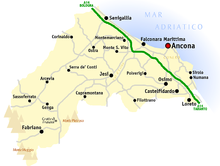Attack on Ancona
| date | May 23, 1915 to May 24, 1915 |
|---|---|
| place | Ancona and the surrounding area |
| output | Austro-Hungarian victory |
| Parties to the conflict | |
|---|---|
| Troop strength | |
| 3 dreadnought battleships , 8 pre-dreadnought battleships, 2 rapid cruisers , 9+ destroyers, 8+ torpedo boats |
1 destroyer 2 airships |
| losses | |
|
unknown human losses, |
63 dead, |
The attack on Ancona was a naval battle between the Austro-Hungarian Navy and the Italian Regia Marina in the course of the First World War . Austro-Hungarian forces attacked both civilian and military targets throughout the central Italian province of Ancona . This operation represented a response to Italy's entry into the war on the part of the Allies.
course
After the Italian declaration of war on Austria-Hungary on May 23, 1915, the Austro-Hungarian Navy reacted quickly and carried out many attacks on the Marche region in Italy. On the day war was declared, the destroyer SMS Dinara and the torpedo boat Tb 53T attacked the port of Ancona .
The destroyer SMS Lika shot at a semaphore and a radio station in Vieste on a reconnaissance voyage between Palagruža and Cape Gargano. The defense of these Italian waters was up to the Italian destroyer Turbine at that time . When the two ships met, there was a small skirmish, from which the Lika emerged victorious. In doing so, she damaged the Italian destroyer.
The next day, May 24, 1915, the majority of the Austro-Hungarian fleet left Pula for the Adriatic Sea . The association consisted of three dreadnoughts , the SMS Viribus Unitis , the SMS Tegetthoff and the SMS Prinz Eugen , accompanied by 8 pre-dreadnoughts . Other Austro-Hungarian ships were already in enemy waters or were heading straight for the coast of the province of Ancona. There the fleet shelled some coastal cities, with the city of Ancona in particular suffering great damage.
The battleship SMS Tegetthoff shot at the Italian airship Città di Ferrara off Ancona together with the destroyer SMS Velebit . The pre-dreadnought SMS Radetzky and two torpedo boats Potenza Picena also attacked . Then they returned to the Pula naval base. Another ship of the line, the SMS Zrinyi , carried out an attack on Senigallia together with two torpedo boats, in which a train was destroyed and a train station and a bridge were destroyed before the association set off back to Pula. The torpedo boat SMS Tb 3 was unsuccessfully attacked by an Italian flying boat .
The kuk Rapidkreuzer SMS Admiral Spaun shot at the shipping sign on the island of Cretaccio, while the SMS Sankt Georg attacked Rimini together with two torpedo boats and destroyed a freight train in the process. At the same time, the destroyer SMS Streiter fired at the shipping sign near Torre di Mileto . Also in the course of the attack, a unit consisting of the light cruiser SMS Novara , a destroyer and two torpedo boats drove into the Corsini Canal and damaged an Italian torpedo boat station, some coastal artillery batteries and a semaphore station.
The SMS Helgoland , another rapid cruiser, met the Italian destroyer Turbine , supported by 4 destroyers south of Pelagosa . The destroyer SMS Tatra also shot at the embankment near the Manfredonia train station. In the end, kuk flying boats attacked Venice and seaplane hangars in Chiaravalle.
consequences
The Austro-Hungarian Navy caused severe damage. In Ancona alone 63 people died, both civilians and military personnel. In this attack, the losses of the Austro-Hungarian Navy were only marginal. In the further course of the sea war in the Adriatic, the Royal Navy set up a large naval blockade known as the Otranto Barrier . This should often be attacked by Austro-Hungarian naval units.
literature
- Robert, ed. Gardiner: Conway's All the World's Fighting Ships, 1906-1921 . Naval Institute Press, Annapolis, Maryland 1985, ISBN 0-87021-907-3 , OCLC 12119866 .
- VE Tarrant: The U-Boat Offensive: 1914-1945 . Naval Institute Press, Annapolis, Maryland 1989, ISBN 0-87021-764-X , OCLC 20338385 .
- Lothar Baumgartner, Erwin Sieche: The ships of the k. (U.) K. Kriegsmarine im Bild = Austro-Hungarian warships in photographs ( German ). Verlagbuchhandlung Stöhr, Vienna 1999, ISBN 3-901208-25-9 , OCLC 43596931 .
- Thomas Sakmyster: Hungary's Admiral on Horseback . East European Monographs, Boulder, CO 1994. ISBN 0-88033-293-X
- John Flournoy Montgomery, The Unwilling Satellite, New York, The Devin-Adair Company 1947, ISBN 1-931313-57-1
- Owen Rutter , Regent of Hungary: The Authorized Life of Admiral Nicholas Horthy London, Rich and Cowan, 1938
Web links
- Combined operations in the Adriatic 1915-1918
- Information about the Tegetthoff class
- Austro-Hungarian Navy
Individual evidence
- ↑ Grga Novak: Jadransko more u i sukobima borbama kroz stoljeća , Volume 2, Split of 2004.


